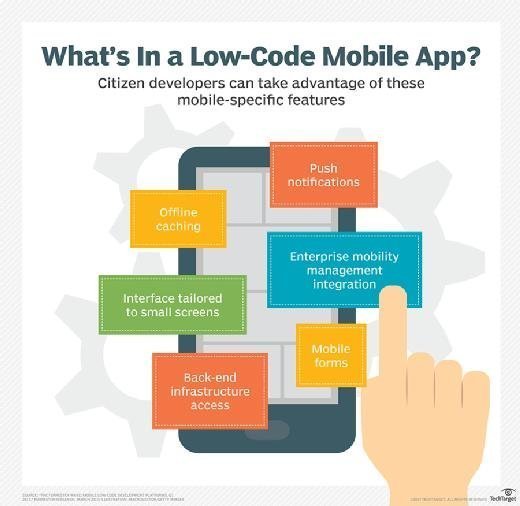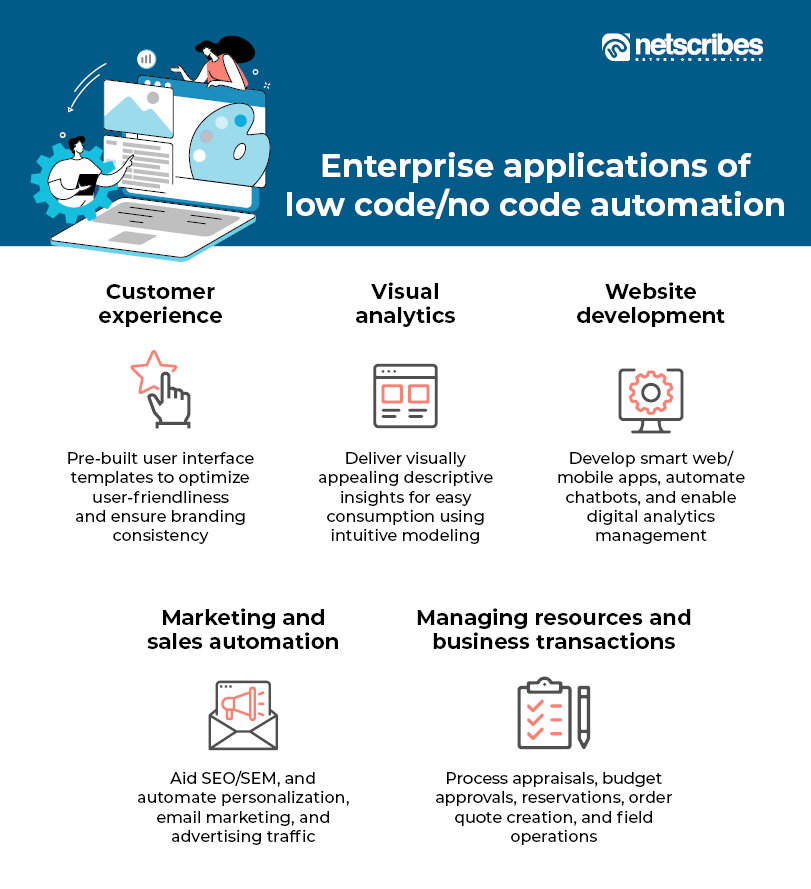New Ideas For Deciding On Low-code platforms for application development
New Ideas For Deciding On Low-code platforms for application development
Blog Article
Benefits Of Low-Code Application Development For Non-Developers
Due to a number of factors, Low-code Application Development is a possibility for non-developers. They are also known as "citizen designers."
Drag-and Drop Builders: Low code platforms include drag-and-drop interfaces that let non-developers create apps without having to write any code. This makes the process of developing easier for people with technical background.
WYSIWYG editor: The "What you see is the result you will get" editors allow users to create interfaces, workflows, and other features in a way which closely resembles the final product. They are easy to comprehend and utilize.
Simplified Design of Logic and Workflow
Visual Workflow Design: Users are able to easily design business process and application logic using diagrams, models, and flowcharts. They are much easier to use than traditional coding.
Low-code platforms usually come with pre-built logic components (e.g., conditions loops, statements) which eliminate the need for complicated programming.
Reusable Templates and Components
Libraries of prebuilt templates Low-code platforms often provide templates libraries for various types of application. This allows non-developers the opportunity to start with a solid basis and then modify it according to their needs.
Reusable widgets and modules The creation of web pages is made simpler by using reusable components as well as modules. This means that there is less need for deep technical knowledge.
Tutorials and guides for development:
Step-by-step guide Platforms provide tutorials, tips on screen, and a set of development steps to help non-developers build applications.
Interactive Tutorials Interactive tutorials are hands-on and interactive that allow users to learn by doing. This increases the confidence of users in the platform.
Integration with existing tools:
Seamless Integration: Low-code platforms have been designed to be easily integrated with the existing business tools and systems (e.g. CRM ERP, CRM) and allow non-programmers to build applications that fit within their current workflows.
APIs/Connectors: The APIs/Connectors built-in enable non-developers to connect their apps to external services.
Collaboration Features:
Team Collaboration Real-time collaboration, shared workspaces, and shared workspaces enable business analysts, non-developers and other stakeholders to effectively collaborate with developers who are professionals.
Access Control based on Role: Users who are not developers can be assigned specific roles and access levels. This enables them to contribute to development without compromising security and functionality.
Automated Debugging, Debugging, and Testing
Test Tools Included: Many low-code platforms include built-in testing and debugging tools. These tools automatize the process, making it easy for non-developers to ensure their apps are functioning properly.
Error Highlighting: Whenever problems arise, the platform highlights mistakes and suggests solutions by guiding non-developers through troubleshooting procedures.
The general rule is that low-code application development has the ability to open up development to a wider audience. This is an important advantage for non-developers. Low-code platform platforms empower business users with easy-to-use, visual and guidance tools. They can then actively contribute to the development and maintaining the applications. Read the top rated her explanation on Low-code Platform for application development for site tips including ms azure sql, rapid applications, software for app development, jdbc server, application modernization, cross platform mobile app development, low code development platforms, developing mobile apps, develop web application, build with docker and more.
Benefits Of Low-Code Application Development In Terms Of Scalability And Flexible
Low-code development of applications offers a variety of advantages regarding scalability and flexibility, which are crucial for building applications that are able to adapt to business demands and be able to adapt to the changing demands. Here are a few of the main benefits rapid scaling:
Cloud-Based Platforms: Many platforms that support low-code use cloud computing. They let applications easily scale up and down with the cloud infrastructure. This lets businesses handle increased loads without worrying about the management of servers.
Auto-Scaling Features: Built-in auto scaling capabilities automatically alter resources based on the demand. This provides constant performance during peak periods without manual intervention.
Flexible Architecture:
Modular Application Design: The low-code platform promotes modular application design. Components can be independent developed, tested and increased in size. Modularity increases flexibility and facilitates modifications or expansions to specific parts without impacting the whole system.
Microservices Integration Support for microservices architecture allows applications to be built as a collection of loosely coupled services, enhancing the scalability as well as flexibility.
Custom-designed solutions:
Extensibility. Low-code platforms typically allow for custom coding or scripting. This allows developers to extend the application's functionality beyond the capabilities it offers in the standard package. It allows developers to meet their own business needs without any restrictions.
Third-Party Integrations: The capability of companies to integrate APIs and applications from third parties, as well as add new features to their application when required, expands its capabilities.
Agile Development and Deployment
Continuous Delivery and Deployment: Low-code platform support agile methodologies which allow continuous integration, continuous delivery (CI/CD). This allows for the rapid release of new features and updates, while ensuring that applications can evolve quickly as a result of user feedback and market changes.
Iterative Development: The iterative nature of low-code development implies that applications can be improved incrementally and scaled, reducing the risk associated with large-scale changes and permitting greater control over growth.
Resource Optimization
Effective Resource Management: Low-code systems assist optimize the usage of resources through providing tools to monitor and manage application performance. This ensures that resources are utilized efficiently and can be scaled either up or down depending on actual demands.
Load Balance: This function allows the application to handle the load of heavy traffic by spreading workloads over several servers. It also ensures that the performance remains consistent.
Global Reach
Multi-Region Deployment: Low-code systems generally support deployment across multiple geographical regions, which allows businesses to provide low-latency services to users worldwide. This is crucial for applications that cater to an international audience.
Support for Localization: The built-in support of localization lets the software be easily adapted to different languages and the requirements of diverse markets.
Updates and maintenance
Simple Maintenance : Low-code programs with a modular and visual design simplifies maintenance tasks. This lets bugs and updates to be made quickly, with no long periods of downtime.
Version Control Systems for Version Control help manage changes and rollbacks, ensuring that updates can be released in a safe manner and older versions can be restored if required.
Cost Efficiency:
Low-code platforms can cut development costs by reducing the requirement for extensive code. They allow developers to expand applications without significant cost or effort.
Pay-as-you go models: Many platforms for low-code provide flexible pricing options, such a pay-as-you-go model that aligns the cost and usage to the actual growth.
Low-code development offers businesses numerous advantages, including scalability flexibility and ad-hoc flexibility. This enables them to develop robust, flexible, and scalable apps. These platforms permit quick adjustments to changing demands and efficient use of resources and continuous improvement, ensuring that applications develop and grow in line with business needs. Read the best wavemaker.com coding for site recommendations including app dev platform, mobile development platforms, stored sql procedures, develop web application, low code platforms, rapid application design, rapid action development, lowcode no code, mobile development platforms, build with docker and more.
Low-Code Applications Offer Benefits In Terms Of Collaboration And Workflow
Low-code development can offer many benefits in collaboration and workflow. This makes it a great solution for businesses looking to increase productivity and speed up the development process. Here are a few of the advantages.
Unified Development Environment: Low-code platforms offer a unified, single environment in which all team members such as business analysts, developers designers, and others can work effectively. This helps eliminate silos and encourages more effective communication.
Visual Development Tools: Low-code platforms are easy to use and have the drag-and-drop interface. This allows non-technical members of the team to participate during the development process and ensures that business requirements are captured accurately.
Communication Enhancement
Real-Time Collaboration A number of low-code platforms have real-time features such as editing and commenting simultaneously or immediate feedback. This allows for continuous communication, and helps decrease the time that is spent in back-and forth discussions.
Shared workspaces: Teams can to work together in shared workspaces in which they edit and discuss the project's elements. This helps ensure that everyone is working towards the same goal and are on the same team.
A streamlined Workflow Management System:
Built-in Project Management Tools: Low code platforms often have integrated project management software that helps teams plan, track, control, and coordinate their development projects. This includes assigning tasks, monitoring progress, and managing deadlines.
Workflow automation: Automating repetitive workflows and tasks can reduce the chance of errors and manual work, allowing teams and individuals to focus on more strategic initiatives and improve efficiency.
More efficient cycles of iteration:
Rapid Prototyping Low-code platforms are ideal for quick prototyping. Iterative development is also feasible and allows teams to experiment, create and refine their applications in shorter times. This provides rapid feedback and improvements.
Support for agile development: Supporting agile practices allows teams to collaborate continuously during sprints. This allows them to adjust and provide small incremental improvements to functionality.
Accessibility for Non-Developers
Citizen-driven development platforms enable business users to modify and create applications without requiring a lot of programming knowledge. This alleviates the burden of IT as well as development teams and can provide faster responses to business needs.
Training and Onboarding - Simple interfaces, comprehensive training materials, and intuitive interfaces make it easier for new team members get up to speed and boost the overall team collaboration.
Centralized Documentation and Knowledge Sharing:
Low-code platforms usually have tools for creating, managing and storing documents within their platforms. This allows the entire project's information to be centrally stored and easily accessible.
Knowledge Repositories : Teams can create knowledge repositories, which include templates, best practices and reuseable components. This facilitates knowledge sharing and helps reduce duplication of effort.
Consistency & Standardization
Standardized Components: The use of standardized, pre-built components ensures consistency across applications and makes it simpler for teams to comprehend and work on different parts of an undertaking.
Governance and compliance: Built within governance frameworks, the frameworks for governance ensure that all development is in line with the organization's standards and requirements of the regulatory environment, reducing non-compliance risks and ensuring the applications are of high-quality standards.
Feedback Loops and Improvement Loops
Integrated Feedback Mechanisms Low-code platforms usually have integrated feedback mechanisms, allowing users to provide easy feedback to applications. This can later be integrated into the development process.
Continuous Improvement: The capability to quickly test and deploy changes as a result of feedback ensures the continuous improvement of the applications. They are closely aligned to the requirements of users as well as goals of the business.
Visualization and Reporting
Real-Time Analytics Reporting and Analytics built-in tools give real-time insight into project progress, performance and user interaction, enabling data-driven decision-making.
Visual Workflow Mapping - Visual tools that show workflows and process can help teams optimize their workflows by identifying bottlenecks.
For collaboration, low-code apps are ideal for reducing workflows, bring teams from different backgrounds together and streamline tasks. This encourages a collaborative environment with a quick and efficient process for development, which results in higher-quality apps and a more effective alignment between the business goals.